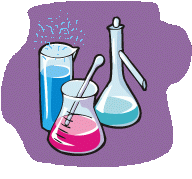


Description of experiment
Below follows a plain text transcript of the selected experiment.
![]()
Needed compounds:
-----------------
sodium azide : NaN3
bleach : NaClO
acetic acid : CH3COOH
Class:
------
elem=N,Cl
redox
Summary:
--------
Azide ion reacts with hypochlorite, giving a yellow compound, which is
colorless in the gaseous state. This compound can easily be ignited and
explodes with a really loud report, even when very small quantities are used.
Description:
------------
Dissolve a small spatula of sodium azide in water and add some acetic acid. Mix
the liquid, such that an homogeneous solution is obtained, which strongly
smells of vinegar.
Take some household bleach and add this to the solution of sodium azide with
acetic acid: The liquid turns yellow and a colorless gas is produced. When the
liquid is swirled carefully, more of the colorless gas is produced.
Keep a small flame near the formed gas: A violent explosion occurs. The bang is
really loud.
----------------------------------------------------------
Another experiment, which allows production of somewhat purer gas and gives
more control over the amount of material which is ignited, is the following:
Dissolve some sodium azide in household bleach (use plain bleach, without
perfumes and detergents) in a test tube. To this solution add half a ml of 80%
acetic acid: The liquid turns golden yellow. Gas is produced vigorously. When
the liquid is shaken more gas is produced.
Loosely cover the test tube with a small piece of glass and swirl until no more
gas is produced: A very faint yellow/green color can be observed in the gas
mix, the liquid still is golden yellow.
In a tub, filled with cold water, put the test tube with the gas, still
coverted by the piece of glass and turn it upside down under water and then
bubble the gas into another test tube, which is completely filled with water.
Then loosely stopper the test tube and transfer it to a beaker, such that its
open end is under water. Allow this test tube to stand for several hours, while
it still is loosely stoppered: After a few hours, half of the volume of gas is
dissolved in the water. The water has a very fai
Put the test tube in a tub, filled with water, in which some dishwashing soap
is dissolved. Bubble the gas from the test tube to the surface. Bubbles of gas
are formed on the surface and these bubbles do not pop immediately. Light some
of the bubbles with a cigarette lighter, before they pop: Each bubble on the
surface gives a loud bang when it is ignited.
=====================================
In this experiment, the highly explosive chlorine azide, ClN3 is formed. This
is a colorless gas, which is only slightly soluble in water. When this gas is
ignited, it explodes with extreme violence.
What is the nature of the golden yellow compound in solution? It might be an
intermediate compound, which decomposes to chlorine azide and something else,
which remains in solution.
The net reaction in the somewhat acidic solution is: HN3 + HOCl --> ClN3 + H2O
![]()